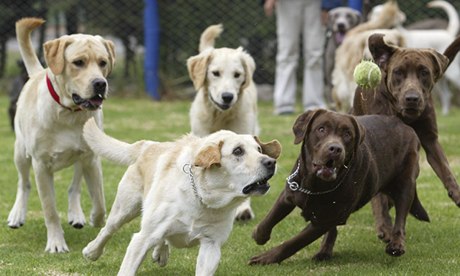Dogs communicate different feelings with right or leftward tail wagging
A dog can distinguish a happy, friendly pooch from an anxious, threatening one from the way it wags its tail

The direction of a dog's tail-wagging reflects how the two halves of its brain process different experiences. Photograph: Jose Miguel Gomez/Reuters
Dogs can tell how other dogs are feeling from the way their tails are wagging, according to researchers who monitored the animals' heart rate as they watched canine movies.
The Italian team found that dogs had higher heart rates and became more anxious when they saw others wag their tails more to the left, but not when they wagged more to the right, or failed to wag at all.
The curious form of communication is probably not intentional, or consciously understood, but is instead an automatic behaviour that arises from the structure of the brain, said Giorgio Vallortigara, director of the animal cognition and neuroscience lab at the University of Trento.
"It's not something they explicitly understand," Vallotigara told the Guardian. "It's just something that happens to them."
Vallotigara traces the effect back to the way the two halves of the brain process different experiences. In a previous study, his team showed that when a dog had a positive encounter, such as seeing its owner, activity rose in the left side of the brain, which brought about more tail wagging to the right. But a negative experience, such as being confronted by an aggressive and unfamiliar dog, had the opposite effect: greater activity in the right side of the brain, and more tail wagging to the left.
The effect is barely visible to the human eye because dogs tend to wag their tails too fast, but it can be seen with slow motion video, or in some larger breeds that wag their tails with less gusto. "In some cases, the bias is so extreme that you can see their tails touching the flank on one side but not on the other," said Vallotigara.
In the latest study, the researchers wanted to find out whether the direction of tail wagging had any effect on other dogs. To get an answer, they fitted dogs with vests that recorded their heart rates, and played them movies of other dogs wagging their tails one way and then the other. To ensure the dogs reacted only to tail wagging, and not appearance, they repeated the experiment with dogs that appeared only as silhouettes.
"When dogs saw other dogs wagging their tails to the right, there was quite a relaxed reaction and no evidence of an increased heart rate. But when the wagging was to the left we saw an increase in heart rate and a series of behaviours typically associated with stress, anxiety and being more alert," Vallotigara said.
The anxious animals held their ears up, panted, crouched a little and kept their eyes wide open. The study appears in the latest issue of Current Biology.
Vallotigara said the effect was comparable to the apparent human preference for wider pupils. In one 1975 study, women were described in more appealing terms when their pupils were larger. Another study, from 2007, found that women's pupils got bigger when they looked at pictures of potential partners. In neither case were people aware that pupil size was sending out a signal, said Vallotigara.
He said biases in tail wagging were hard to spot with the naked eye, but the finding might still help to improve animal welfare.
"This paper is extremely interesting from a dog owner's perspective," said Louise McDowell, a psychologist at Queen's University, Belfast, who studies how activity on different sides of the brain affect animal behaviour. "If a dog wags their tail to the left upon reunion with their owner, this may be a cause of serious concern, as it suggests that the right hemisphere is activated, which controls for negative emotional responses, including fear and withdrawal."
No comments:
Post a Comment